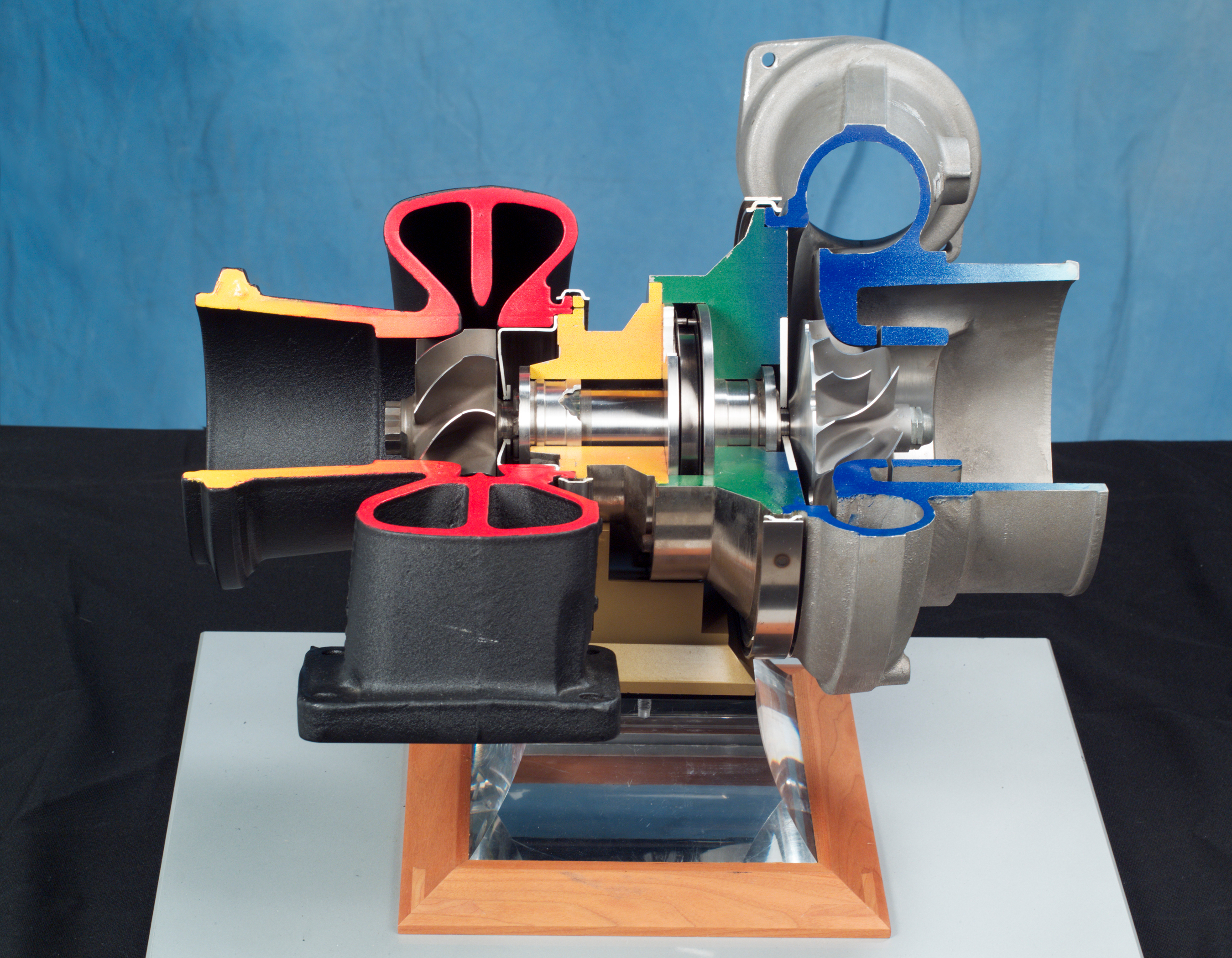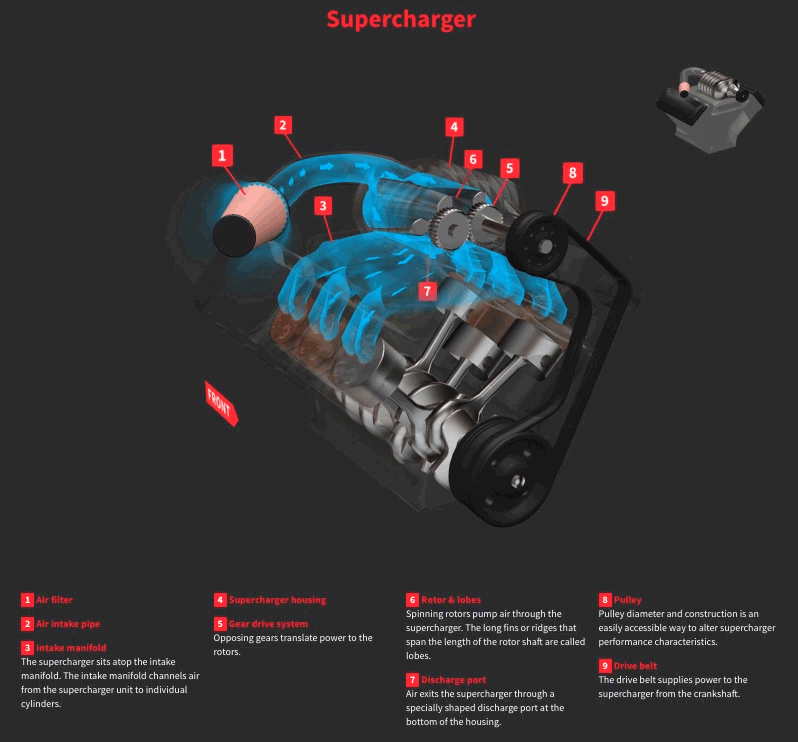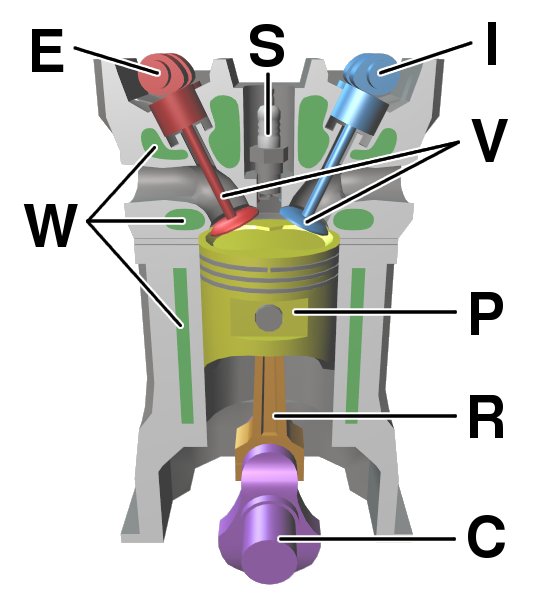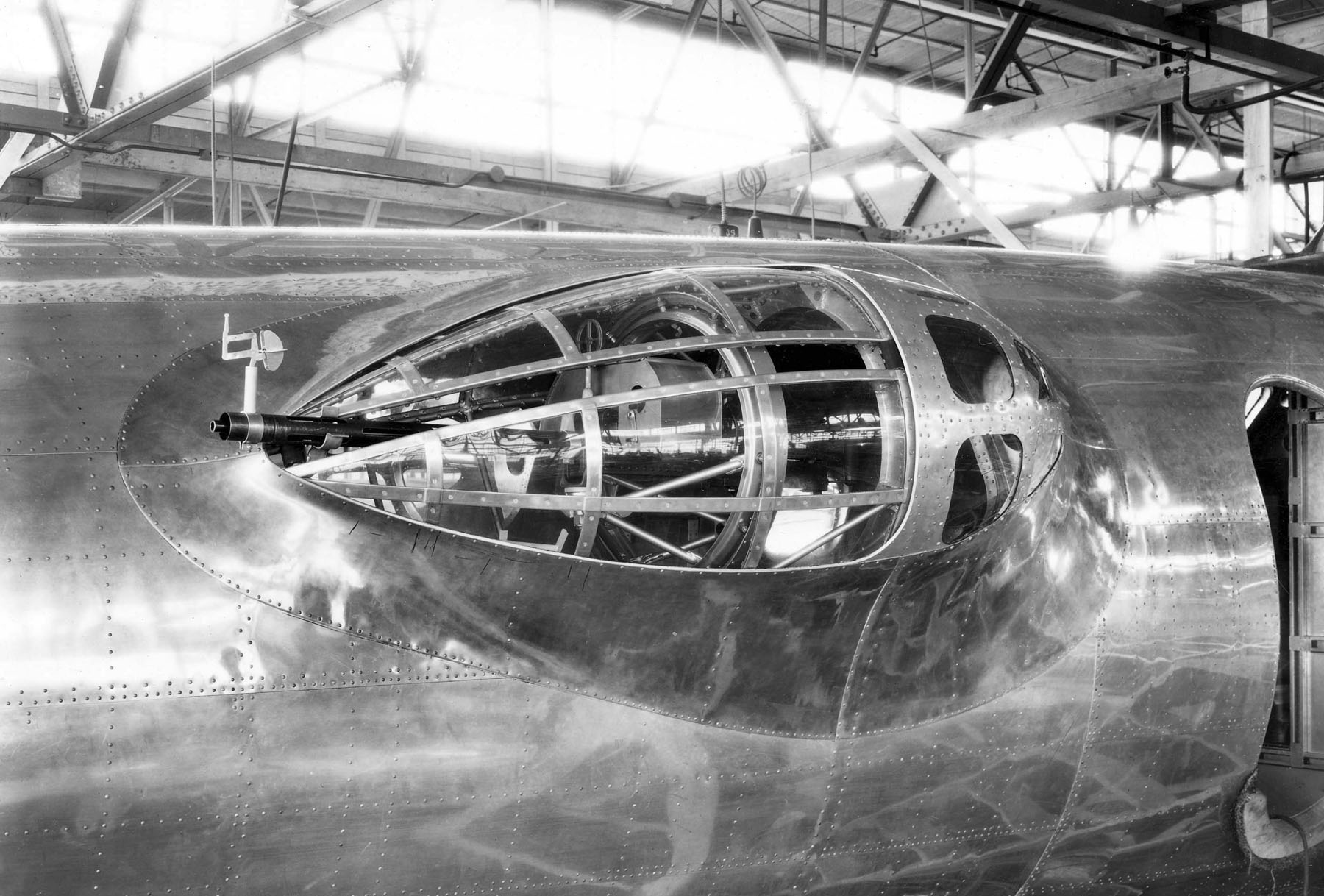|
Turbocharger
In an internal combustion engine, a turbocharger (often called a turbo) is a forced induction device that is powered by the flow of exhaust gases. It uses this energy to compress the intake gas, forcing more air into the engine in order to produce more power for a given displacement. The current categorisation is that a turbocharger is powered by the kinetic energy of the exhaust gasses, whereas a is mechanically powered (usually by a belt from the engine's crankshaft). However, up until the mid-20th century, a turbocharger was called a "turbosupercharger" and was considered a type of supercharger. History Prior to the invention of the turbocharger,[...More Info...] [...Related Items...] OR: [Wikipedia] [Google] [Baidu] |
Supercharger
In an internal combustion engine, a supercharger compresses the intake gas, forcing more air into the engine in order to produce more power for a given displacement. The current categorisation is that a supercharger is a form of forced induction that is mechanically powered (usually by a belt from the engine's crankshaft), as opposed to a turbocharger, which is powered by the kinetic energy of the exhaust gasses. However, up until the mid-20th century, a turbocharger was called a "turbosupercharger" and was considered a type of supercharger. The first supercharged engine was built in 1878, with usage in aircraft engines beginning in the 1910s and usage in car engines beginning in the 1920s. In piston engines used by aircraft, supercharging was often used to compensate for the lower air density at high altitudes. Supercharging is less commonly used in the 21st century, as manufacturers have shifted to turbochargers to reduce fuel consumption and/or increase power outputs. D ... [...More Info...] [...Related Items...] OR: [Wikipedia] [Google] [Baidu] |
Centrifugal Compressor
Centrifugal compressors, sometimes called impeller compressors or radial compressors, are a sub-class of dynamic axisymmetric work-absorbing turbomachinery. They achieve pressure rise by adding energy to the continuous flow of fluid through the rotor/impeller. The following equation shows this specific energy input. A substantial portion of this energy is kinetic which is converted to increased potential energy/static pressure by slowing the flow through a diffuser. The static pressure rise in the impeller may roughly equal the rise in the diffuser. Equation-0.1 : H = \left( \left( R \right)_2 - \left( R \right)_1 \right) :where the control volume nomenclature (illustrated in Figure-0.4) is: ::* subscript, is the impeller inlet location, station1 ::* subscript, is the impeller discharge/exit location, station2 ::* is the energy input per unit mass, units=(LP/m) ::* is the impeller's rotation speed, units=(radians/t) ::* is the radius of specified location, units=(L) ::* is ve ... [...More Info...] [...Related Items...] OR: [Wikipedia] [Google] [Baidu] |
Alfred Büchi
Alfred Büchi (July 11, 1879 – October 27, 1959) was a Swiss engineer and inventor. He was best known as the inventor of turbocharging. Büchi was born July 11, 1879, in Winterthur, Switzerland, growing up there and in Ludwigshafen. He was the son of Johann Büchi, a chief executive at Swiss industrial engineering and manufacturing firm Sulzer. He was well-positioned to pursue a similar field and would eventually achieve fame as a result of his inventions. In 1899 he enrolled as a machine engineering student at Federal Polytechnic Institute (ETH) in Zürich, receiving a degree in 1903. From there he practised engineering in Belgium and England before returning to Switzerland ( Wetzikon) in 1908. The turbocharger During his early years outside Switzerland, Büchi became fascinated with the challenge of improving combustion engine efficiency relating to exhaust heat loss. Büchi's patents Büchi's patent, No. 204630 received from the Imperial Patent Office of the Ger ... [...More Info...] [...Related Items...] OR: [Wikipedia] [Google] [Baidu] |
Forced Induction
In an internal combustion engine, forced induction is where turbocharging or supercharging is used to increase the density of the intake air. Engines without forced induction are classified as naturally aspirated. Operating principle Overview Forced induction is often used to increase the power output of an engine. This is achieved by compressing the intake air, to increase the mass of the air-fuel mixture present within the combustion chamber. A naturally aspirated engine is limited to a maximum intake air pressure equal to its surrounding atmosphere; however a forced induction engine produces "boost", whereby the air pressure is higher than the surrounding atmosphere. Since the density of air increases with pressure, this allows a greater mass of air to enter the combustion chamber. Theoretically, the vapour power cycle analysis of the second law of thermodynamics would suggest that increasing the mean effective pressure within the combustion chamber would also increa ... [...More Info...] [...Related Items...] OR: [Wikipedia] [Google] [Baidu] |
Sanford Alexander Moss
Sanford Alexander Moss (August 23, 1872 – November 10, 1946) was an American aviation engineer, who was the first to use a turbocharger on an aircraft engine. Life and career Sanford Moss was born 1872 in San Francisco, California to Ernest Goodman Moss and Josephine Sanford. He received his B.S. and M.S. in engineering from the University of California, San Francisco. On August 23, 1899, he married Jennie Edith Somerville Donnely in Chicago, Illinois. Moss received his Ph.D. from Cornell University where he built his first gas turbine engine. In 1903 after graduation, Moss became an engineer for General Electric's Steam Turbine Department in Lynn, Massachusetts.Leyes, p.231-232. At GE he worked with Elihu Thomson, Edwin W. Rice, and Charles Steinmetz. While there, he applied some of his concepts in the development of the turbosupercharger. His design used a small turbine wheel, driven by exhaust gases, to turn a supercharger. In autumn of 1917 William F. Durand, Directo ... [...More Info...] [...Related Items...] OR: [Wikipedia] [Google] [Baidu] |
Focke-Wulf Fw 190
The Focke-Wulf Fw 190, nicknamed ''Würger'' ("Shrike") is a German single-seat, single-engine fighter aircraft designed by Kurt Tank at Focke-Wulf in the late 1930s and widely used during World War II. Along with its well-known counterpart, the Messerschmitt Bf 109, the Fw 190 became the backbone of the (Fighter Force) of the . The twin-row BMW 801 radial engine that powered most operational versions enabled the Fw 190 to lift larger loads than the Bf 109, allowing its use as a day fighter, fighter-bomber, ground-attack aircraft and to a lesser degree, night fighter. The Fw 190A started flying operationally over France in August 1941 and quickly proved superior in all but turn radius to the Supermarine Spitfire (early Merlin-powered variants)#Mk V (Mk V (Types 331, 349 and 352)), Spitfire Mk. V, the main front-line fighter of the Royal Air Force (RAF), particularly at low and medium altitudes. The 190 maintained superiority over Allies of World War II, Allied fighters until th ... [...More Info...] [...Related Items...] OR: [Wikipedia] [Google] [Baidu] |
Lockheed P-38 Lightning
The Lockheed P-38 Lightning is an American single-seat, twin piston-engined fighter aircraft that was used during World War II. Developed for the United States Army Air Corps by the Lockheed Corporation, the P-38 incorporated a distinctive twin boom, twin-boom design with a central nacelle containing the cockpit and armament. Along with its use as a general fighter aircraft, fighter, the P-38 was used in various aerial combat roles, including as a highly effective fighter-bomber, a night fighter, and a Range (aircraft), long-range escort fighter when equipped with drop tanks. The P-38 was also used as a bomber-pathfinder, guiding streams of medium bomber, medium and heavy bombers, or even other P-38s equipped with bombs, to their targets."P-38 Lightning" National M ... [...More Info...] [...Related Items...] OR: [Wikipedia] [Google] [Baidu] |
Consolidated B-24 Liberator
The Consolidated B-24 Liberator is an American heavy bomber, designed by Consolidated Aircraft of San Diego, California. It was known within the company as the Model 32, and some initial production aircraft were laid down as export models designated as various LB-30s, in the Land Bomber design category. At its inception, the B-24 was a modern design featuring a highly efficient shoulder-mounted, high aspect ratio Davis wing. The wing gave the Liberator a high cruise speed, long range and the ability to carry a heavy bomb load. Early RAF Liberators were the first aircraft to cross the Atlantic Ocean as a matter of routine. In comparison with its contemporaries, the B-24 was relatively difficult to fly and had poor low-speed performance; it also had a lower ceiling and was less robust than the Boeing B-17 Flying Fortress. While aircrews tended to prefer the B-17, General Staff favored the B-24 and procured it in huge numbers for a wide variety of roles. At approximately ... [...More Info...] [...Related Items...] OR: [Wikipedia] [Google] [Baidu] |
Chevrolet Corvair
The Chevrolet Corvair is a compact car manufactured by Chevrolet for model years 1960–1969 in two generations. A response to the Volkswagen Beetle, it remains the only American-designed, mass-produced passenger car with a rear-mounted, air-cooled engine. The Corvair was manufactured and marketed in 4-door sedan, 2-door coupe, convertible, 4-door station wagon, passenger van, commercial van, and pickup truck body styles in its first generation (1960–1964) and as a 2-door coupe, convertible or 4-door hardtop in its second (1965–1969) – with a total production of approximately 1.8 million from 1960 until 1969. The name "Corvair" originated as a portmanteau of Corvette and Bel Air, a name first applied in 1954 to a Corvette-based concept with a hardtop fastback-styled roof, part of the Motorama traveling exhibition. When applied to the production models, the "air" part referenced the engine's cooling system. A prominent aspect of the Corvair's legacy derives fr ... [...More Info...] [...Related Items...] OR: [Wikipedia] [Google] [Baidu] |
Internal Combustion Engine
An internal combustion engine (ICE or IC engine) is a heat engine in which the combustion of a fuel occurs with an oxidizer (usually air) in a combustion chamber that is an integral part of the working fluid flow circuit. In an internal combustion engine, the expansion of the high- temperature and high- pressure gases produced by combustion applies direct force to some component of the engine. The force is typically applied to pistons (piston engine), turbine blades ( gas turbine), a rotor (Wankel engine), or a nozzle (jet engine). This force moves the component over a distance, transforming chemical energy into kinetic energy which is used to propel, move or power whatever the engine is attached to. This replaced the external combustion engine for applications where the weight or size of an engine was more important. The first commercially successful internal combustion engine was created by Étienne Lenoir around 1860, and the first modern internal combustion engine, ... [...More Info...] [...Related Items...] OR: [Wikipedia] [Google] [Baidu] |
Boeing B-17 Flying Fortress
The Boeing B-17 Flying Fortress is a four-engined heavy bomber developed in the 1930s for the United States Army Air Corps (USAAC). Relatively fast and high-flying for a bomber of its era, the B-17 was used primarily in the European Theater of Operations and dropped more bombs than any other aircraft during World War II. It is the third-most produced bomber of all time, behind the four-engined Consolidated B-24 Liberator and the multirole, twin-engined Junkers Ju 88. It was also employed as a transport, antisubmarine aircraft, drone controller, and search-and-rescue aircraft. In a USAAC competition, Boeing's prototype Model 299/XB-17 outperformed two other entries but crashed, losing the initial 200-bomber contract to the Douglas B-18 Bolo. Still, the Air Corps ordered 13 more B-17s for further evaluation, then introduced it into service in 1938. The B-17 evolved through numerous design advances but from its inception, the USAAC (later, the USAAF) promoted the aircraf ... [...More Info...] [...Related Items...] OR: [Wikipedia] [Google] [Baidu] |


.jpg)
.jpg)




